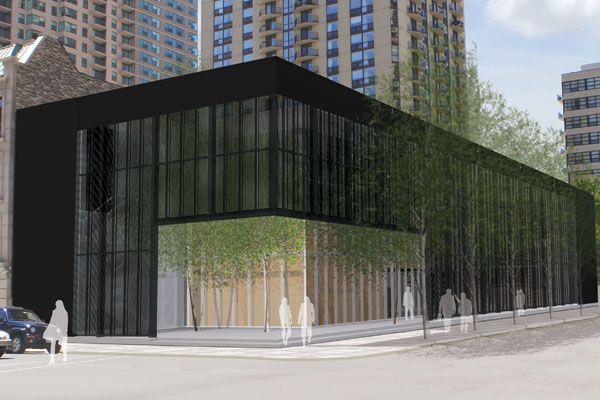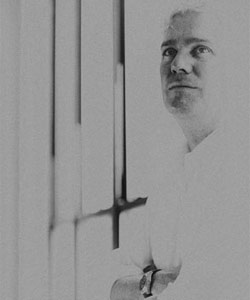
A rendering of Poetry‘s new home at Dearborn and Superior Streets

Chicago architect John RonanLike a poet staring at a blank piece of paper, John Ronan had virtually nothing to start with when designing the Poetry Foundation’s new headquarters at Dearborn and Superior Streets, set to open June 25. “There aren’t buildings designed directly for poetry,” says the Chicago-based architect. “So the fun of it is, it’s more about questions than answers: What is a building for poetry?”
If the project was unique, so was its history: After nearly a century of bohemian existence, in 2002 Poetry magazine received a bequest in excess of $100 million from the pharmaceutical heiress Ruth Lilly, which paved the way for a first-of-its-kind writing center. Ronan, 47, a fan of the poets Seamus Heaney and Rainer Maria Rilke, was hired in 2007 after an international search.
As executed, the 22,000-square-foot, $21.5 million building looks simple on the surface but has a layered materiality that invites exploration—the same way a well-crafted poem works on the reader. “It’s not something that screams at you,” Ronan says. “This is a building, not a poem. We didn’t want to start writing poetry into the façade. We wanted to arrange the materials and spaces analogously to how a poet arranges words—to help you see something you didn’t see before.” One such arrangement is an open-air grove of deciduous trees that Ronan wrapped in the building’s glass-and-black-zinc exterior walls. The landscape creates a haven apart from the city that surrounds it, and the garden of trees, moss, and rocks then becomes one of the building’s centerpieces, visible from the library, offices, and the performance space.
Positioning the performance space in view of the trees is a deft stroke of simplicity, but the space itself required meticulous planning. While large enough to seat 125, the room has to accommodate whisper-quiet poets without electronic amplification. To accomplish this, Ronan attended to everything from the space’s dimensions to the forms and materials of the walls,ceiling, and chairs.
“Pick the wrong chairs and they’re going to be squeaking during readings,” says the architect, who is known for carefully arranging details. At the five-year-old Gary Comer Youth Center in the Grand Crossing neighborhood, Ronan designed an exterior that is a riot of brightly colored rectilinear panels. The panels signal a vibrant energy within the building—in contrast to its dreary surroundings—and they’re easily replaced in the event of graffiti or vandalism. At Christ the King Jesuit College Prep, a Ronan design in the Austin neighborhood, the chapel features a crucifix made of steel cables, and the acoustic walls are lined with crucifix-shaped cutouts.
Inside the Poetry Foundation’s center, a serene two-story library stocks a unique 35,000-volume collection that dates back to nearly 1912, when the Chicago writer Harriet Monroe founded a magazine for verse. But for all the poetry contained in the building, there’s little fanfare out front—no signage until visitors wind their way to the garden threshold, where “Poetry Foundation” is spelled out on a stone step.
The aim, Ronan says, was to create a building “that has poetic qualities, like subtlety. It’s not giving it all away in one shot—which has become de rigueur in architecture now, [where] it’s so about getting in design magazines and having this photogenic icon.” —Dennis Rodkin
One of only three structures in the country dedicated to verse, the new Poetry Foundation building will house a performance space, a public garden, and a library. Through book launches, a reading series, and youth outreach, the foundation hopes to draw as wide an audience as possible—and, in doing so, to challenge the perception that poetry is a marginal art form. “In the first edition of Poetry magazine, published in October 1912, Harriet Monroe imagined it would be a place for poetry as an art form to have a space of its own, like dance or theatre. What this building really does is fulfill that vision,” says John Barr, the foundation’s president. The move will be marked by a two-day celebration on June 25 and 26. Free and open to the public, the event will feature Elizabeth Alexander, best known for writing President Obama’s 2009 inauguration poem; Sandra Cisneros, author of the Latino coming-of-age novel The House on Mango Street; and the Pulitzer Prize winner Robert Hass. For information about the opening and other events, go to poetryfoundation.org. —Paula Carter
Rendering: Courtesy of John Ronan Architects; Photograph: Chris Strong


